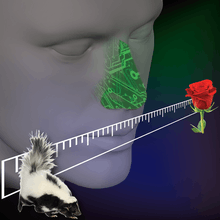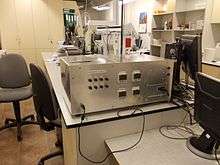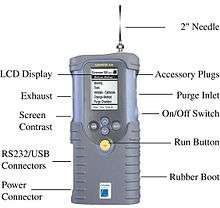Electronic nose

An electronic nose is a device intended to detect odors or flavors.
Over the last decade, "electronic sensing" or "e-sensing" technologies have undergone important developments from a technical and commercial point of view. The expression "electronic sensing" refers to the capability of reproducing human senses using sensor arrays and pattern recognition systems. Since 1982,[2] research has been conducted to develop technologies, commonly referred to as electronic noses, that could detect and recognize odors and flavors. The stages of the recognition process are similar to human olfaction and are performed for identification, comparison, quantification and other applications, including data storage and retrieval. However, hedonic evaluation is a specificity of the human nose given that it is related to subjective opinions. These devices have undergone much development and are now used to fulfill industrial needs.
Other techniques to analyze odors
In all industries, odor assessment is usually performed by human sensory analysis, by chemosensors, or by gas chromatography. The latter technique gives information about volatile organic compounds but the correlation between analytical results and actual odor perception is not direct due to potential interactions between several odorous components.
In the Wasp Hound odor detector, the mechanical element is a video camera and the biological element is five parasitic wasps who have been conditioned to swarm in response to the presence of a specific chemical.[3]
History
Scientist Alexander Graham Bell popularized the notion that it was difficult to measure a smell,[4] and in 1914 said the following:
Did you ever measure a smell? Can you tell whether one smell is just twice strong as another? Can you measure the difference between two kinds of smell and another? It is very obvious that we have very many different kinds of smells, all the way from the odour of violets and roses up to asafetida.But until you can measure their likeness and differences, you can have no science of odour. If you are ambitious to find a new science, measure a smell.
— Alexander Graham Bell, 1914[5]
In the decades since Bell made this observation, no such science of odor materialised, and it was not until the 1950s and beyond that any real progress was made.[4]
Working principle
The electronic nose was developed in order to mimic human olfaction that functions as a non-separative mechanism: i.e. an odor / flavor is perceived as a global fingerprint. Essentially the instrument consists of head space sampling, sensor array, and pattern recognition modules, to generate signal pattern that are used for characterizing odors.
Electronic noses include three major parts: a sample delivery system, a detection system, a computing system.
The sample delivery system enables the generation of the headspace (volatile compounds) of a sample, which is the fraction analyzed. The system then injects this headspace into the detection system of the electronic nose. The sample delivery system is essential to guarantee constant operating conditions.
The detection system, which consists of a sensor set, is the "reactive" part of the instrument. When in contact with volatile compounds, the sensors react, which means they experience a change of electrical properties.
In most electronic noses, each sensor is sensitive to all volatile molecules but each in their specific way. However, in bio-electronic noses, receptor proteins which respond to specific odor molecules are used. Most electronic noses use sensor arrays that react to volatile compounds on contact: the adsorption of volatile compounds on the sensor surface causes a physical change of the sensor. A specific response is recorded by the electronic interface transforming the signal into a digital value. Recorded data are then computed based on statistical models.[6]
Bio-electronic noses use olfactory receptors - proteins cloned from biological organisms, e.g. humans, that bind to specific odor molecules. One group has developed a bio-electronic nose that mimics the signaling systems used by the human nose to perceive odors at a very high sensitivity: femtomolar concentrations.[7]
The more commonly used sensors for electronic noses include
- metal–oxide–semiconductor (MOSFET) devices - a transistor used for amplifying or switching electronic signals. This works on the principle that molecules entering the sensor area will be charged either positively or negatively, which should have a direct effect on the electric field inside the MOSFET. Thus, introducing each additional charged particle will directly affect the transistor in a unique way, producing a change in the MOSFET signal that can then be interpreted by pattern recognition computer systems. So essentially each detectable molecule will have its own unique signal for a computer system to interpret.
- conducting polymers - organic polymers that conduct electricity.[8]
- polymer composites - similar in use to conducting polymers but formulated of non-conducting polymers with the addition of conducting material such as carbon black.
- quartz crystal microbalance - a way of measuring mass per unit area by measuring the change in frequency of a quartz crystal resonator. This can be stored in a database and used for future reference.
- surface acoustic wave (SAW) - a class of microelectromechanical systems (MEMS) which rely on the modulation of surface acoustic waves to sense a physical phenomenon.[9]
Some devices combine multiple sensor types in a single device, for example polymer coated QCMs. The independent information leads to vastly more sensitive and efficient devices.[10]
In recent years, other types of electronic noses have been developed that utilize mass spectrometry or ultra-fast gas chromatography as a detection system.[6]
The computing system works to combine the responses of all of the sensors, which represents the input for the data treatment. This part of the instrument performs global fingerprint analysis and provides results and representations that can be easily interpreted. Moreover, the electronic nose results can be correlated to those obtained from other techniques (sensory panel, GC, GC/MS). Many of the data interpretation systems are used for the analysis of results. These systems include artificial neural network (ANN), fuzzy logic, pattern recognition modules, etc.[11]
Performing an analysis
As a first step, an electronic nose needs to be trained with qualified samples so as to build a database of reference. Then the instrument can recognize new samples by comparing volatile compounds fingerprint to those contained in its database. Thus they can perform qualitative or quantitative analysis. This however may also provide a problem as many odours are made up of multiple different molecules, this may be possibly wrongly interpreted by the device as it will register them as different compounds, resulting in incorrect or inaccurate results depending on the primary function of a nose.[12]
Applications

Electronic nose instruments are used by research and development laboratories, quality control laboratories and process & production departments for various purposes:
In quality control laboratories
- Conformity of raw materials, intermediate and final products
- Batch to batch consistency
- Detection of contamination, spoilage, adulteration
- Origin or vendor selection
- Monitoring of storage conditions.
In process and production departments
- Managing raw material variability
- Comparison with a reference product
- Measurement and comparison of the effects of manufacturing process on products
- Following-up cleaning in place process efficiency
- Scale-up monitoring
- Cleaning in place monitoring.
Possible and future applications in the fields of health and security
- The detection of dangerous and harmful bacteria, such as software that has been specifically developed to recognise the smell of the MRSA (Methicillin-resistant Staphylococcus Aureus).[13] It is also able to recognise methicillinsusceptible S. aureus (MSSA) among many other substances. It has been theorised that if carefully placed in hospital ventilation systems, it could detect and therefore prevent contamination of other patients or equipment by many highly contagious pathogens.
- The detection of lung cancer or other medical conditions by detecting the VOC's (volatile organic compounds) that indicate the medical condition.[14][15][16]
- The detection of viral and bacterial infections in COPD Exacerbations[17]
- The quality control of food products as it could be conveniently placed in food packaging to clearly indicate when food has started to rot or used in the field to detect bacterial or insect contamination.[18]
- Nasal implants could warn of the presence of natural gas, for those who had anosmia or a weak sense of smell.
- The Brain Mapping Foundation used the electronic nose to detect brain cancer cells.[19][20][21][22][23][24][25]
Possible and future applications in the field of crime prevention and security
- The ability of the electronic nose to detect odourless chemicals makes it ideal for use in the police force, such as the ability to detect drug odours despite other airborne odours capable of confusing police dogs. However this is unlikely in the mean time as the cost of the electronic nose is too great and until its price drops significantly it is unlikely to happen.
- It may also be used as a bomb detection method in airports. Through careful placement of several or more electronic noses and effective computer systems you could triangulate the location of bombs to within a few metres of their location in less than a few seconds.
In environmental monitoring
- For identification of volatile organic compounds in air, water and soil samples.[26]
- For environmental protection.[27]
Various application notes describe analysis in areas such as flavor and fragrance, food and beverage, packaging, pharmaceutical, cosmetic and perfumes, and chemical companies. More recently they can also address public concerns in terms of olfactive nuisance monitoring with networks of on-field devices.[28][29] Since emission rates on a site can be extremely variable for some sources, the electronic nose can provide a tool to track fluctuations and trends and assess the situation in real time. It improves understanding of critical sources, leading to pro-active odor management. Real time modeling will present the current situation, allowing the operator to understand which periods and conditions are putting the facility at risk. Also, existing commercial systems can be programmed to have active alerts based on set points (odor concentration modeled at receptors/alert points or odor concentration at a nose/source) to initiate appropriate actions.
Example of electronic nose

The Cyranose 320 is a handheld “electronic nose” developed by Cyrano Sciences of Pasadena, California in 2000.[30] Cyrano Sciences was founded in 1997, 9 years after the concept of an “electronic nose” based on using multiple semi-selective sensors combined with electronic computation was first proposed by Gardner and Bartlett.[31] The Cyranose 320 is based on sensor research performed by Professor Nathan Lewis of the California Institute of Technology.[32] Applications researched using the Cyranose 320 include the detection of COPD,[33] and other medical conditions[34][35] as well as industrial applications generally related to quality control or contamination detection.[36]
See also
- Chemical field-effect transistor
- Chemiresistor
- Electronic skin
- Electronic tongue
- Fluctuation-enhanced sensing
- Machine olfaction
- Olfactometer
References
- ↑ Haddad et al., doi:10.1371/journal.pcbi.1000740
- ↑ Persaud, Krishna; Dodd, George (1982). "Analysis of discrimination mechanisms in the mammalian olfactory system using a model nose". Nature. 299 (5881): 352–5. doi:10.1038/299352a0. PMID 7110356.
- ↑ "Wasp Hound". Science Central. Retrieved 23 February 2011.
- 1 2 http://www.chemosensory.com/chemosense/chemosense-Sept03.pdf[]
- ↑ Wise, P. M.; Olsson, MJ; Cain, WS (2000). "Quantification of Odor Quality". Chemical Senses. 25 (4): 429–43. doi:10.1093/chemse/25.4.429. PMID 10944507.
- 1 2 "Sensory expert and Analytical Instruments". alpha-mos.com.
- ↑ Jin, Hye Jun; Lee, Sang Hun; Kim, Tae Hyun; Park, Juhun; Song, Hyun Seok; Park, Tai Hyun; Hong, Seunghun (2012). "Nanovesicle-based bioelectronic nose platform mimicking human olfactory signal transduction". Biosensors and Bioelectronics. 35 (1): 335–41. doi:10.1016/j.bios.2012.03.012. PMID 22475887.
- ↑ Summary of electronic nose technologies - Andrew Horsfield
- ↑ Röck, Frank; Barsan, Nicolae; Weimar, Udo (2008). "Electronic Nose: Current Status and Future Trends". Chemical Reviews. 108 (2): 705–25. doi:10.1021/cr068121q. PMID 18205411.
- ↑ http://www.chem.ucla.edu/dept/Faculty/gimzewski/publications/219_2010_SensorsActuatorsB.pdf[]
- ↑ "What the nose knows". The Economist. 9 March 2006.
- ↑ Summary of electronic nose technologies
- ↑ Dutta, Ritaban; Dutta, Ritabrata (2006). "Intelligent Bayes Classifier (IBC) for ENT infection classification in hospital environment". BioMedical Engineering OnLine. 5: 65. doi:10.1186/1475-925X-5-65. PMC 1764885
 . PMID 17176476.
. PMID 17176476. - ↑ Dragonieri, Silvano; Van Der Schee, Marc P.; Massaro, Tommaso; Schiavulli, Nunzia; Brinkman, Paul; Pinca, Armando; Carratú, Pierluigi; Spanevello, Antonio; Resta, Onofrio (2012). "An electronic nose distinguishes exhaled breath of patients with Malignant Pleural Mesothelioma from controls". Lung Cancer. 75 (3): 326–31. doi:10.1016/j.lungcan.2011.08.009. PMID 21924516.
- ↑ Timms, Chris; Thomas, Paul S; Yates, Deborah H (2012). "Detection of gastro-oesophageal reflux disease (GORD) in patients with obstructive lung disease using exhaled breath profiling". Journal of Breath Research. 6 (1): 016003. doi:10.1088/1752-7155/6/1/016003. PMID 22233591.
- ↑ Bikov A, Hernadi M, Korosi BZ, Kunos L, Zsamboki G, Sutto Z, Tarnoki AD, Tarnoki DL, Losonczy G, Horvath I. Expiratory flow rate, breath hold and anatomic dead space influence electronic nose ability to detect lung cancer. BMC PULMONARY MEDICINE 14:(1) Paper 202. 9 p. (2014)
- ↑ Geffen, Wouter H. van; Bruins, Marcel; Kerstjens, Huib A. M. (2016-01-01). "Diagnosing viral and bacterial respiratory infections in acute COPD exacerbations by an electronic nose: a pilot study". Journal of Breath Research. 10 (3): 036001. doi:10.1088/1752-7155/10/3/036001. ISSN 1752-7163.
- ↑ Degenhardt, David C.; Greene, Jeremy K.; Khalilian, Ahmad (2012). "Temporal Dynamics and Electronic Nose Detection of Stink Bug-Induced Volatile Emissions from Cotton Bolls". Psyche. 2012: 1–9. doi:10.1155/2012/236762.
- ↑ http://www.sciencedaily.com/releases/2009/04/090430065456.htm
- ↑ Babak Kateb, M. A. Ryan, M. L. Homer, L. M. Lara, Yufang Yin, Kerin Higa, Mike Y.Chen; Sniffing Out Cancer Using the JPL Electronic Nose: A Novel Approach to Detection and Differentiation of Brain Cancer, NeuroImage 47(2009), T5-9
- ↑ "NASA's e-nose to fight brain cancer: Study". NDTV.com. 4 May 2009.
- ↑ "NASA's ENose sniffs for cancer". theregister.co.uk.
- ↑ Ross Miller. "NASA's new e-nose can detect scent of cancerous brain cells". Engadget. AOL.
- ↑ "Why Brain Mapping Matters". EverydayHealth.com.
- ↑ Michael Cooney (30 April 2009). "NASA's electronic nose can sniff out cancer, space stench". Network World.
- ↑ http://eponline.com/articles/2006/11/01/a-sensitive-electronic-nose.aspx[]
- ↑ Pogfay, Tawee; Watthanawisuth, Natthapol; Pimpao, W.; Wisitsoraat, A.; Mongpraneet, S.; Lomas, T.; Sangworasil, M.; Tuantranont, Adisorn (19–21 May 2010). Development of Wireless Electronic Nose for Environment Quality Classification. 2010 International Conference on Electrical Engineering/Electronics Computer Telecommunications and Information Technology. pp. 540–3.
- ↑ "Sensory expert and Analytical Instruments". alpha-mos.com.
- ↑ "Pima County Marks Years of Odor Management Innovation". Odotech.
- ↑ "Cyrano Sciences Unveils Portable Electronic Nose". foodingredientsonline.com. 2000.
- ↑ Wilson, Alphus D.; Baietto, Manuela (2009). "Applications and Advances in Electronic-Nose Technologies". Sensors. 9: 5099–5148. doi:10.3390/s90705099.
- ↑ Unmesh Kher (March 12, 2000). "Electronic Noses Sniff Out a Market or Two". Time magazine.
- ↑ Fens, N; Zwinderman, AH; van der Schee, MP; de Nijs, SB; Dijkers, E; Roldaan, AC; Cheung, D; Bel, EH; Sterk, PJ (Dec 2009). "Exhaled breath profiling enables discrimination of chronic obstructive and asthma". Am J Respir Crit Care Med. 180 (11): 1076–82. doi:10.1164/rccm.200906-0939OC.
- ↑ "Sensigent". sensigent.com.
- ↑ Bikov A, Lazar Z, Horvath I. Established methodological issues in electronic nose research: how far are we from using these instruments in clinical settings of breath analysis? JOURNAL OF BREATH RESEARCH 9:(3) Paper 034001. 18 p. (2015)
- ↑ "Cyrano "Nose" the Smell of Success". spinoff.nasa.gov. 2001.
External links
- Dutta, Ritaban; Dutta, Ritabrata (2006). "Intelligent Bayes Classifier (IBC) for ENT infection classification in hospital environment". BioMedical Engineering OnLine. 5: 65. doi:10.1186/1475-925X-5-65. PMC 1764885
 . PMID 17176476.
. PMID 17176476. - NASA researchers are developing an exquisitely sensitive artificial nose for space exploration
- BBC News on Electronic Nose based bacterial detection
- OdowatchTM Overview - Youtube